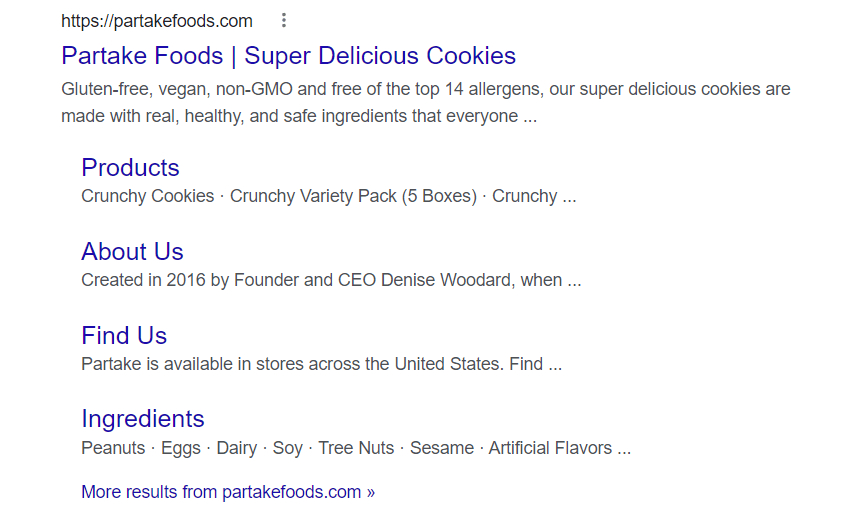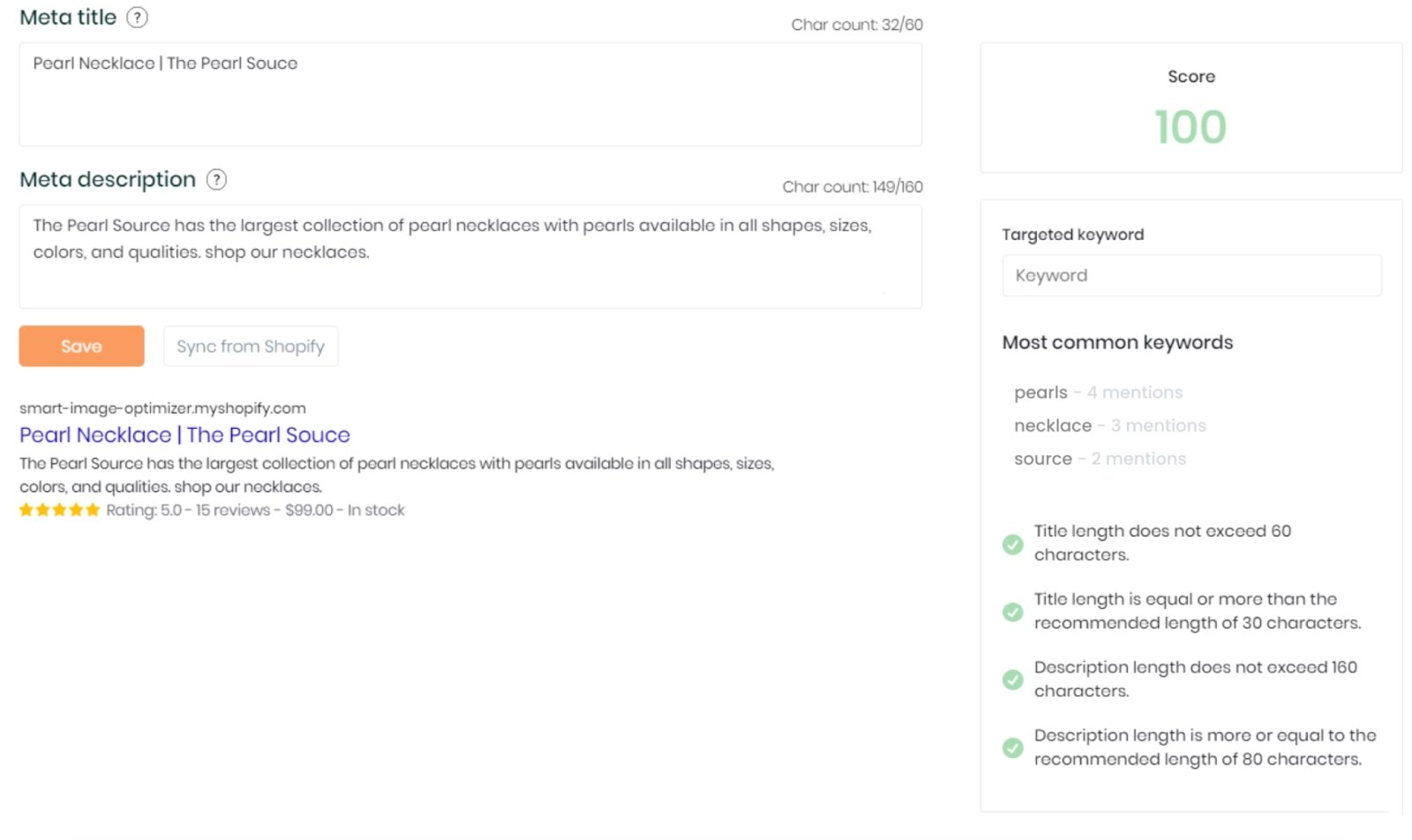Shopify meta descriptions and meta titles can help your store in several ways. Like getting high rankings in SERPs and showing a potential customer what your store is really about. A well-written, clear, and striking meta title and description can help you not only increase impressions, but also your store’s click-through rate.
In this article, we’ll talk about what this metadata is, how to write it and how to add it to your Shopify store. We’ll also provide you with examples, and share some useful tips.
Let’s start, then.
Make the process of writing Shopify meta descriptions a breeze
Get TinyIMGWhat is a meta description?
A meta description is a short and explicit text that appears in search engine results along with a clickable title tag. Meta descriptions inform your visitors of what your page is about. You should use it to attract more clicks (possible customer visits) from the SERP.
Moreso, it’s an important part of an overall Shopify SEO strategy.
In Shopify stores, meta description should be used for product and collection pages, homepage, and blog posts. You can also add meta-descriptions to strandart pages like Shipping and returns and Terms and Conditions, but this is optional.
How to write meta descriptions for Shopify?
A good meta description can be one of the quickest ways to sell your product. But how to make it profitable? Let’s find that out:
- Think of your potential customer. Whether it’s a product page or a homepage, you must be confident about what you sell and why it is worth buying. This way, your customer gets an image of the quality he’s about to enjoy.
- Stand out. Anyone can copy the most compelling meta tags found in competitors. However, it’s important that you make it unique, representative, and clear. Highlight your brand within a few words.
- Keep it short. On average, a meta description should include from 155 to 160 characters. Basically, two optimal sentences. If you go any longer, Google is most likely to cut off a part that exceeds the specified amount.
- Greet the customer. Make your meta description welcoming – introduce to your production and invite them to discover something that he has never seen before. But make sure you don’t overuse smart and fancy words.
- Use your main keyword. Find a place to put in your head keyword and try your best to make it sound natural. This will help search engines rank your page better.
In the next sections, we’ve shared tips on writing meta descriptions for specific types of pages in your Shopify store.
Shopify homepage meta-description
Your homepage is the face of the store. It’s important that the description represents what your shop offers.
This is what to keep in mind before writing your homepage meta description:
- Use a relevant keyword, but focus on natural, direct language
- Don’t use lists, bullet points, tables.
- Include a call-to-action that invites a potential customer to your store.
- Generally describe your store without going into specific products – unless it’s a one-product store.
- Add a USP that would help your store to stand out from any other competitor.
Shopify product page meta-description
This is where you advertise a specific product – make sure the potential customer gets all the information you want to provide to them while they’re still in the SERP.
See tips on writing a meta description for Shopify product page:
- Describe the product by using features, benefits, and everything else that didn’t fit in the title.
- Emphasize what makes your product so unique that the customer should choose it.
- Make your product description sensory.
- Add selling terms like: free shipping, free returns, or other marketing offers that are applicable to the product.
Finally, a meta description is where your customer can get a very first impression of your store, so make sure you present your products originally. Answer the question that your customer has while looking for the product.
Let us help you automate those Shopify product page meta descriptions
Get TinyIMGShopify collection page meta-description
Collections are useful for grouping products so it’s easier for the customer to find what they want by category.
Remember this before writing a meta description for your collection page:
- Describe what products a potential customer will find in this collection.
- Mirror the main characteristic of the collection.
- Use high-selling terms, such as: environmentally conscious, sustainable, wide selection, and others, if applicable.
- Don’t forget to brag about ongoing sales. Mention the exact discount and extras you’re offering.
- Mention the starting price of some high-selling products from the collection. But make sure the price actually applies to the product, and if there are any changes, the meta description is updated too.
Suggested reading
Meta-descriptions for other Shopify pages
No matter what Shopify page you’re about to create your meta description for, there are the same leading tips to follow. First and foremost, it should include the most popular keywords related to the page content. Keep the text short and easy to understand.
What is a meta title?
The meta title, also known as a title tag, is a clickable text link displayed in search engine results pinpointing the website's subject. A good meta title is descriptive and includes the target keyword for that page, usually in the beginning.
How to write meta titles for Shopify?
A well-arranged meta title equals a modern shop billboard that attracts new customers. Here we will tell you how to make an eye-catching meta title specifically for Shopify:
- Include high-ranking keywords. Make sure you do thorough research to get to know your market better. And, of course, include the head keyword, which will answer the customer’s search matter.
- Make it clear. Meta titles are definitely not a place for deep meanings. Help your customer understand what to expect from your store in a blink of an eye.
- Stay original. Don’t head to some meta title generator straight away. Represent your product using a unique meta title that helps you reach your goal.
- Respect the character count. Your Shopify meta title should include from 55 to 66 characters to fit Google’s requirements well. If the number goes beyond, Google will delete the rest of the text, and your idea will be lost.
Shopify homepage meta-title
Your homepage meta-title is your store’s facade, which introduces the customer to your merchandise. In other words, it’s the most influential text on your Shopify store.
Here’s what to keep in mind before writing your Shopify home page meta-title:
- Include your Shopify store name, and it’s recommended you separate it using a vertical bar.
- Make the title representative but also easy to understand, so the search engine can easily find it for the potential customer.
- Mention your main strength. Whether it’s the amount of assortment you have or the way you make it.
Shopify product page meta-title
With a good product page meta-title, you can start emptying your stock seamlessly.
Find tips for writing a product page meta title below:
- Clearly write the product’s name so people can easily find it when they search for it.
- Include serial numbers, features, models – basically anything that would provide a reader with enough information to click.
Shopify collection page meta-title
This is space for letting your customer know that you have a whole category of his desired products.
Keep this in mind before making your collection page meta title live:
- Clearly write the category name in the meta title.
- Use invitation words like: explore, check out, and such.
- Mention ongoing discounts.
- Let the customer know if the shipping is free.
- Perhaps the collection has newly arrived? Inform your customer using keywords, such as New arrivals.
Meta-titles for other Shopify pages
Just like meta descriptions, meta titles for other Shopify pages require clarity and well-picked keywords. However, considering that meta titles include even fewer characters (55-60), you should be able to present your shop picturesquely using only a few words.
That being said, whatever page you need to introduce, make sure your customer will be able to catch an idea of what he’s about to find.
Check you meta-data right now with our online Meta Title and Description Checker Tool
Shopify meta description and meta title examples
Let’s look at some Shopify stores that nailed the meta title and description game.
Homepage
Here’s a store that sells delicious cookies (or so they say). The title is short and punchy – if you search “delicious cookies” on Google, the title can’t get any better.
In the meta description, you see more specifics of what kind of cookies the store sells. The first several words say it all. You’ll immediately know if you want to stay or look for other delicious cookies.
Product page
Here’s a Shopify store that sells jeans. That’s it. Their focused and targeted marketing shows in metadata as well. In this example, we see a product page for a pair of relaxed women’s jeans.
The meta description is really descriptive – it focuses on the type of jeans and its main characteristics. You can clearly tell if the jeans they’re describing are up your alley or not.
Collection page
This last store sells makeup for dark skin women – and this specific example is about highlighters. The description immediately catches the eye by talking about a common problem women have with this product.
After posing a rhetorical question, the description moves to specific highlighter characteristics. When you finish reading it, you already have all the information you need about the category.
This Shopify meta description is a perfect length, not cut-off, not rewritten by Google, and generally well-executed.
Add and edit Shopify meta descriptions and meta titles
In order to add and edit meta tags to all your store’s pages, your Shopify theme has to support built-in SEO features. That includes your homepage, all product pages, collection pages, and other/general pages.
Whether the Shopify theme supports those SEO features, you’ll only find out after adding and/or editing meta titles and descriptions. Below we present step-by-step instructions on how to do that for different types of pages on your Shopify store.
To add a meta title and description for the homepage, follow these steps:
- Go to Online Store > Preferences
- Write the title and description by following best SEO practices
- View your homepage’s source code to see if meta tags are updated like you wanted to. If not, that means your Shopify theme is not compatible with built-in SEO features and you’ll need to edit the template. For that, we have a separate section later on in the article.
For the product pages, follow these steps:
- Go to Products
- Choose a product
- Click on “Edit website SEO” like pictured in the screenshot below
- Write the title and description that best describes the product
- Check the source code just like you did for the homepage
For the collection pages, follow these steps:
- Go to Products > Collections
- Choose a collection you want to edit meta tags to
- Click on “Edit website SEO”
- Write the meta title and description that best describes your collection page
- Check the source code just like you did for the homepage and product pages
For other/general pages, follow these steps:
- Go to Online Store > Pages
- Choose a page you want to add SEO title and description to
- Write the title and description that best describes the page
- Check the source code just like you did for all previous pages
Now that you know how to update your Shopify store’s metadata, let’s jump to the section that explains why you might want to install a Shopify app for metadata editing.
Use a Shopify app to edit metadata
Metadata can be tricky to perfect. It involves competitor analysis, extensive SEO knowledge, and time. If you do it on your own straight from your Shopify store, you have to research the rules and best practices yourself.
Not to mention that if your store is big, it will also be time-consuming to add meta titles and descriptions for all product pages.
So, if you want to make the process of adding meta titles and meta descriptions to your product pages easier, try out a Shopify app like TinyIMG.
Here are the advantages it offers:
- Add and edit meta titles easy with no prior SEO knowledge
- Personalized tips that help you write the best metadata
- Automatic keyword suggestions for meta-description and meta-titles
- Metadata automation to create meta-description and title in bulk
Edit your Shopify store's metadata with TinyIMG
Install TinyIMG nowEdit your Shopify store theme
If you write your meta title and description according to the steps we’ve provided in the previous section, but nothing shows up after checking the source code, it means you have to edit the template itself.
In order to do that, follow these steps:
- Go to the admin section, then go to Online Store > Themes
- Click “Actions”, and from the dropdown menu choose “Edit code”
- Click on the “theme.liquid” file on the left side. This is the place that will allow you to edit your Shopify template’s meta title and description
- For the title tags, find the text between <title> and </title> and replace it with this:
<title>{{ page_title }}{% if current_tags %} – tagged "{{ current_tags | join: ', ' }}"{% endif %}{% if current_page != 1 %} – Page {{ current_page }}{% endif %}{% unless page_title contains shop.name %} – {{ shop.name }}{% endunless %}</title>
- For the description tags, find the part of the text that starts with <meta name=”description”, and replace it with the text below:
{% if page_description %} <meta name="description" content="{{ page_description | escape }} {% if template contains 'collection' %}{% if current_page > 1 %}Page no. {{ current_page }}{% endif %}{% endif %}" /> {% endif %}
Congrats, you have your metadata ready! Let’s move on to the next section where we provide you with good Shopify metadata examples.
Will Google change your store's metadata in SERP?
There’s a chance Google will change your store’s metadata (sorry about that). An Ahrefs study showed that almost 63% of hand-written meta descriptions are changed.
However, there is no clear evidence for what kind of descriptions will or will not be changed.
We advise you to still keep writing descriptions unless you have thousands of product pages – that could be a bit wasteful in terms of time and energy. In those cases, we also suggest getting a Shopify app like TinyIMG that makes the whole process easy and efficient.
Generally, you should still write your own meta descriptions for your highest-traffic pages and the pages that are meant to rank in SERP. As we’ve already established, a well-written meta description can boost the click-through rate.
Summary
Shopify meta descriptions can convince a potential visitor to visit your website, while meta titles are very important for ranking high in SERP.
You will succeed if you use relevant keywords, don’t exceed character limits, and make sure your titles and descriptions are unique, descriptive, and match the content of the respective page.
You can easily change the metadata on your Shopify store if it supports built-in SEO features, or use an app like TinyIMG to create the best titles and descriptions that represent your site well.
Curious to read more? Check out these articles:


Frequently asked questions
A meta description in Shopify is a short and accurate text that appears in search engine results below the meta title. It can be applied to various pages, like the homepage, collection page, introduction, and more. And it includes heavyweight keywords for better ranking.
A Shopify meta description must consist of 155-160 characters and include the highest-rate keywords related to your page content. Not less important is to make it unique to leave a good impression on a customer.
The title tag displays the name of your page and is visible when you land on that page. Meanwhile, the meta title is used in search engine result pages and can be seen when you’re searching for something on Google as a clickable link that brings you to the respective page.
In case Google doesn’t show your meta descriptions, double-check if the description mirrors what your page is about and try to edit it. Google may replace your meta-description with text from the content if it find the latter more accurate.











